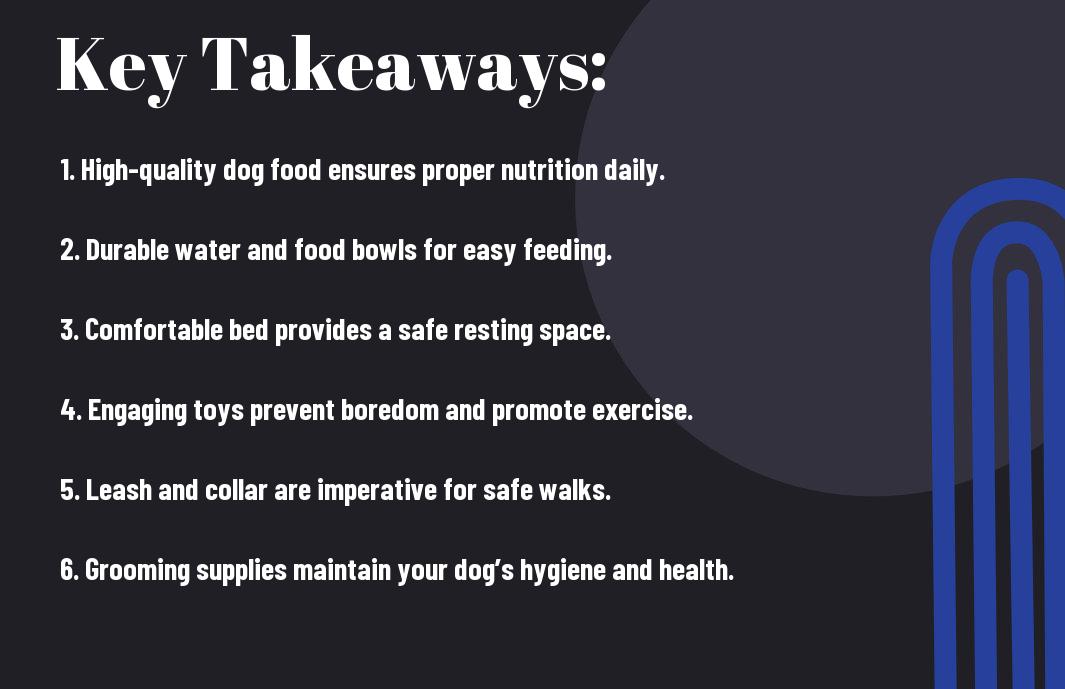Most dog owners want their pets to be happy and healthy, but sometimes it can be challenging to identify when your furry friend is experiencing stress or anxiety. Understanding the subtle signs your dog may display can help you take proactive steps to alleviate their discomfort. In this post, you’ll learn how to recognize these behaviors and what you can do to help your dog feel at ease. With this knowledge, you can create a more soothing environment for your beloved companion.


Understanding Stress and Anxiety in Dogs
Definition of Stress and Anxiety in Pets
One of the first steps in recognizing stress and anxiety in your dog is to understand what these terms mean in the context of animal behavior. Stress in dogs can be defined as a response to a perceived threat or change in the environment that disrupts their usual state of being. This reaction can manifest as various physiological and behavioral signs, such as excessive barking or changes in eating habits. Anxiety, on the other hand, is a more persistent state of unease and worry, often evident even in the absence of an identifiable stressor.
One of the critical distinctions to note is that while stress can be a short-term reaction to something specific, like a loud noise or change in routine, anxiety is often a long-term condition. Both stress and anxiety can create discomfort for your pet, influencing their overall well-being and happiness. Understanding these definitions will help you better identify the signs and symptoms present in your dog.
Common Causes of Stress in Dogs
One of the common causes of stress in dogs includes environmental changes, such as moving to a new home, changes in family dynamics, or the introduction of a new pet. These factors can disturb your dog’s routine and create uncertainty, leading to stress. Other triggers, such as loud noises from storms or fireworks, trips to the vet, and prolonged periods alone, can also contribute to this stress.
The presence of other animals, particularly those that are hostile or unfamiliar, can elevate stress levels in dogs, as can lack of socialization or exposure to novel situations. Creating a safe and stable environment for your dog is paramount in alleviating stress. Regular exposure to different environments and situations, paired with positive reinforcement, can help your pet build resilience against stressors.
The Difference Between Stress and Anxiety
Even though stress and anxiety often manifest in similar ways, distinguishing between the two can help you address your dog’s needs more effectively. Stress is typically a reaction to a specific event or change, while anxiety can be more generalized and may arise without an obvious reason. For example, your dog might show signs of stress during a thunderstorm but could exhibit anxiety when left alone, even when there are no immediate stressors in sight.
A better understanding of these differences allows you to tailor your approach. For instance, while you might work on strategies to mitigate stress during specific events, such as creating a safe space for your dog during thunderstorms, anxiety may require a more comprehensive strategy including behavioral training or consultation with a veterinarian or animal behaviorist.

Recognizing Physical Signs of Stress and Anxiety
If you’re attentive to your dog’s behavior, you may start to notice various physical signs that indicate they are experiencing stress or anxiety. These signs can manifest in several ways, from their body language to changes in daily habits. By being observant, you can identify these issues early on and take steps to support your furry friend in overcoming their discomfort.
Body Language Indicators
Even the most subtle changes in your dog’s body language can reveal a lot about their emotional state. Common signs include a lowered tail, flattened ears, and a tense body posture. If your dog frequently avoids eye contact or displays behaviors such as yawning or licking their lips more than usual, these can also be indicators of discomfort or anxiety. Physical signs like rapid panting or pacing can further highlight that your dog is feeling overwhelmed and stressed.
It’s important to take note of these signs in combination with one another, as context matters. For instance, if your dog displays a tense body posture in a chaotic environment, it could be a direct response to that anxiety-inducing situation. Observing these body language cues consistently can offer you a clearer picture of your dog’s emotional well-being.
Changes in Appetite
On the topic of physical signs, one of the most noticeable changes you may encounter is a shift in your dog’s appetite. Stress or anxiety often leads to decreased food intake, but in some cases, it can also result in increased hunger. If your dog suddenly refuses to eat when they previously had a healthy appetite, or if you notice they seem insatiable despite eating normally, these can be significant red flags indicating they are struggling with emotional or psychological issues.
For instance, you might find that during certain situations—such as a thunderstorm or the arrival of guests—your dog either refuses their food entirely or gobbles it down frantically. Observing these changes regularly can help you understand the connection between their stress triggers and their eating habits.
Altered Bathroom Habits
Changes in your dog’s bathroom habits can also signal that they are experiencing stress or anxiety. This can manifest through increased urination or defecation, as well as accidents in the house if your dog is typically well-house-trained. You may also observe signs of straining or reluctance to go outside when they usually enjoy walks. These behaviors indicate that your dog is struggling to cope with their emotional state, and you should address this concern promptly.
Stress can often lead to gastrointestinal distress, resulting in loose stools or changes in bathroom frequency. When your dog is anxious, it can disrupt their typical routines, leading to unexpected accidents inside your home, even if they have been previously reliable with their bathroom habits. Identifying these shifts early will make a significant difference in helping your beloved pet navigate their feelings.
Identifying Behavioral Signs
After observing your dog for some time, it is important to take notice of any behavioral changes that could signal stress or anxiety. Understanding these signs can ensure that you address your dog’s needs effectively, leading to a happier and healthier life for both you and your pet. Behavioral changes can manifest in various ways, and recognizing these signs early on can help you mitigate the issues before they escalate.
Excessive Barking or Whining
Whining is often a dog’s way of expressing discomfort or anxiety. If you notice that your dog is barking or whining excessively, it may be trying to communicate its distress. These vocalizations can occur due to a variety of triggers, such as separation anxiety, boredom, or fear of loud noises. It is important to pay attention to the context of your dog’s whining or barking, as understanding the cause can guide you to address the root of the problem effectively.
Dogs may also bark or whine more when they are in unfamiliar situations or around new people. If your furry friend seems to become increasingly vocal during stressful moments, it may be time to help them cope with these feelings. Implementing calming strategies, such as providing a safe space or engaging in relaxation exercises, can make a significant difference in their behavior.
Destructive Behavior
An increase in destructive behavior can be a telltale sign that your dog is feeling stressed or anxious. When your once well-behaved dog suddenly starts chewing on furniture, digging holes, or tearing up household items, it may be a cry for help stemming from internal turmoil. Often, these actions serve as outlets for pent-up stress, frustration, or boredom, indicating that your dog may be overwhelmed in some way.
Destructive behavior often results when your dog is left alone for extended periods, leading to separation anxiety. This anxiety can escalate if not addressed, causing your dog to feel trapped or confined. Providing adequate mental and physical stimulation through toys, puzzle games, and regular exercise can help alleviate this anxiety and prevent destructive tendencies.
Withdrawal from Interaction
Clearly, if your dog starts to shy away from social interactions or becomes less interested in engaging with you or your family members, this may indicate stress or anxiety. A once outgoing dog may choose to retreat to a quiet corner or refuse to participate in playtime. Changes in social behavior, like avoiding contact or not responding to calls, can suggest that your dog is overwhelmed by their environment or struggling with emotional distress.
For instance, if you typically find your dog eagerly awaiting your arrival at the door but now only watches from a distance, it may be a sign that they require more support to feel secure. By creating a safe and nurturing environment, you can encourage your dog to gradually reintegrate into social situations at their pace. Additionally, scheduling regular quality time together can strengthen your bond and help restore their confidence.
Environmental Factors Contributing to Stress
Your dog’s environment can play a significant role in their stress levels. Identifying environmental factors that may be contributing to your dog’s anxiety is crucial for providing them with a comfortable and secure atmosphere. Here are some common environmental factors that you should consider:
- Noise sensitivity and loud environments
- Changes in routine
- Presence of other animals or people
Knowing these factors can help you create a more relaxing setting for your furry friend.
Noise Sensitivity and Loud Environments
One important aspect to consider is your dog’s reaction to noise. Many dogs are sensitive to loud sounds, such as thunderstorms, fireworks, or even loud music. If your dog seems to become anxious, pant, or hide during these times, it’s a sign that they may be stressed by the noise. This sensitivity can heighten their overall anxiety, making it crucial for you to identify noise triggers and provide soothing alternatives when needed.
To lessen their anxiety in these situations, consider creating a safe space for your dog. This could involve providing them with a cozy bed in a quieter room, using calming music or white noise machines, or even investing in soundproofing elements for your home. These strategies can help your dog feel more secured when confronted with startling noises.
Changes in Routine
To further understand your dog’s stress triggers, consider how changes in routine might be impacting them. Dogs thrive on stability and predictability, so fluctuations in your schedule, such as a change in work hours or a new family member, can lead to feelings of confusion and anxiety. Even something seemingly minor, like different walking routes, can disrupt their sense of security.
The impact of routine changes can vary from dog to dog. Some may show mild signs of stress, while others can become significantly anxious. Keeping a consistent schedule for feeding, walks, and playtime is crucial in helping your dog feel grounded. This way, they know what to expect and when, which can greatly reduce anxiety levels.
Presence of Other Animals or People
Contributing to your dog’s stress may also be the presence of other animals or unfamiliar people. If your dog is not well-socialized or has had negative experiences with other pets or persons, they may exhibit signs of anxiety when faced with these encounters. Growling, barking, or attempting to flee are all common behaviors that indicate stress in these situations. It’s important to monitor your dog’s reactions and protect them from forced interactions that may lead to anxiety.
Loud gatherings or visits from unfamiliar guests can also trigger stress in your dog. Creating positive experiences through gradual introductions and ensuring your dog has a safe space to retreat to can help them cope with such situations. Reading your dog’s body language and providing reassurance is crucial in helping them feel secure around others.
Health Factors Impacting Stress Levels
To better understand how stress manifests in your dog, it’s crucial to be aware of various health factors that can exacerbate anxiety levels. A dog’s emotional well-being can significantly hinge on their physical health, and recognizing these interconnections is vital. Here are some key health factors to consider:
- Pre-existing health conditions
- Pain or discomfort
- Age-related anxiety
- Changes in routine or environment
- Diet and nutrition
Pre-existing Health Conditions
Impacting your dog’s stress levels, pre-existing health conditions can often contribute to heightened anxiety. For example, dogs with chronic illnesses or conditions such as arthritis or diabetes may feel more vulnerable. This vulnerability can lead to increased sensitivity to stressors in their environment. Thus, staying informed about your dog’s health history is key to recognizing signs of anxiety.
Additionally, some medical conditions can manifest symptoms that look like anxiety. For instance, gastrointestinal issues can lead to restlessness or excessive drooling, which can overlap with what you might interpret as stress or fear. Regular veterinary check-ups are important to monitor these issues and mitigate their impact on your dog’s mental state.
Effects of Pain or Discomfort
If your dog experiences pain or discomfort, it can elevate their stress levels significantly. Dogs often hide their pain, making it difficult for you to know when something is wrong. Increased irritability, reluctance to engage in previously enjoyed activities, and changes in appetite or sleeping patterns can all be signs that your dog is suffering. Understanding these behaviors in the context of potential pain or discomfort can help you address their needs effectively.
Moreover, stress and pain can form a vicious circle; the emotional distress can exacerbate physical pain, creating an ongoing cycle that is tough for your dog to escape. Observing your dog’s interactions and behaviors will equip you with the insights needed to identify discomfort and take appropriate action.
Age-related Anxiety
Assuming your dog is aging, you may notice they experience increased anxiety levels as they get older. Changes in cognitive function, sensory decline, and general physical deterioration can contribute to this heightened state of anxiety. Older dogs may become more sensitive to their environment, reacting to changes that they were previously comfortable with. This behavior can reflect a decline in their ability to cope with stressors they once managed with ease.
Health issues such as canine cognitive dysfunction, akin to dementia in humans, can also play a significant role in age-related anxiety. You might notice your dog becoming disoriented or confused at times, leading to increased stress levels. Being patient and understanding your aging dog’s needs will help you provide the necessary support during this challenging time.
How to Help Your Dog Manage Stress and Anxiety
For many dog owners, recognizing the signs of stress and anxiety in their pets is just the first step. The next vital phase is implementing effective strategies to help your furry friend cope. Creating a calming environment for your dog can significantly contribute to alleviating their stress levels. Whether it’s setting up a secluded corner or using a crate, ensuring that your dog has access to a designated area where they can relax is important. This space should feel secure and safe; consider placing their favorite blanket or toys to make it more inviting. By encouraging your dog to retreat to this safe space during challenging moments, you are empowering them to take charge of their feelings and find comfort on their own terms.
Creating a Safe Space
Anxiety can be mitigated by establishing a safe space that reduces environmental stressors. This area should be quiet, away from loud noises and excessive foot traffic, so your dog can unwind without distractions. You might also want to provide calming items, such as soft bedding or a piece of your clothing, that can make them feel more at ease. Over time, your dog may come to recognize this space as their personal retreat, helping them to better manage anxiety-inducing situations.
Training and Behavioral Modification Techniques
Any successful strategy to help your dog with stress and anxiety includes a structured approach to training and behavioral modification. Positive reinforcement techniques, such as rewarding calm behavior or redirecting their focus when they display signs of anxiety, can be effective. Furthermore, gradually exposing your dog to triggers in controlled settings can help them build resilience and confidence. Consistent training will strengthen your bond with your dog and equip them with the skills needed to navigate their stressful world.
Your commitment to understanding your dog’s behavior can also encourage them to feel secure in your presence. Consistency is key in behavioral modification; the more you practice these techniques, the more successful you’ll be in helping your dog to acclimate to stressors without resorting to anxious behaviors. Incorporate regular training sessions into your routine, ensuring that they are brief, fun, and positive to keep your dog engaged and motivated.
Utilizing Calming Products and Supplements
Now, it’s worth exploring additional tools that can assist your dog in managing stress and anxiety. Many pet owners find that calming products, such as anxiety wraps, pheromone diffusers, or natural supplements, can provide an extra layer of support. These products can help create a more relaxed state for your dog, making it easier for them to cope during tense moments. It is important to consult with your veterinarian before introducing any supplements, as they can help guide you toward safe and effective options suitable for your dog’s specific needs.
Techniques like aromatherapy can also enhance your dog’s sense of calm. Using pet-safe crucial oils or sprays may provide soothing effects, while calming music specifically designed for dogs can create an environment conducive to relaxation. By exploring these products alongside your behavioral training efforts, you can formulate a comprehensive approach that gives your dog the best chance for stress-free living.
When to Seek Professional Help
Once again, recognizing the signs of stress and anxiety in your dog is imperative, but knowing when to seek professional help is equally important. While minor stress signals may resolve with time and patience, there are situations where your furry friend might need more specialized care. Observing your dog closely and understanding the extent of their anxiety will help you decide if it’s time to consult a veterinarian or a professional animal behaviorist.
Signs That Indicate a Need for a Veterinarian
Professional guidance is warranted when you observe persistent behaviors that suggest your dog is experiencing more than just occasional anxiety. If your dog displays significant changes in eating habits, excessive barking, or lethargy, these could be indicators of underlying health issues compounded by stress. Additionally, physical symptoms such as vomiting, diarrhea, or excessive scratching may require immediate attention from a veterinarian to rule out medical problems.
It’s important to act swiftly if your dog exhibits aggressive behavior or extreme fear that seems out of character. These signs can indicate a severe anxiety disorder, and addressing them sooner can lead to a more favorable outcome for your pet. Consulting a veterinarian can provide you with insights not only about your dog’s emotional well-being but also any physical conditions that need treatment.
Finding a Qualified Animal Behaviorist
Professional help from a qualified animal behaviorist can be invaluable for treating anxiety and stress in your dog. Look for a certified behaviorist with a strong educational background and experience in animal behavior. You can find candidates through professional organizations like the Animal Behavior Society or the International Association of Animal Behavior Consultants, which verify their expertise and credentials.
Meeting one-on-one with a behaviorist allows you to discuss your dog’s specific issues and develop a tailored approach to support your pet. Inquire about their treatment philosophy, methods, and experience with similar cases to ensure they are a good fit for your dog’s needs. Effective communication between you and the behaviorist, along with a solid understanding of your dog’s individual behavior, is key to successful intervention.
It is imperative to gather recommendations and reviews from other pet owners when searching for a qualified professional. A behaviorist’s approach to treatment can significantly impact your dog’s progress, so consider seeking multiple referrals and engaging in consultations before making your choice. This will not only help you feel more comfortable with your decision but also ensure that you’re investing in the right support for your furry companion.
Understanding Treatment Options
With the right professional support, you have a variety of treatment options to help alleviate your dog’s anxiety and stress. Treatment may incorporate behavioral modification techniques, environmental changes, medication, or a combination of these methods. It’s important to collaborate closely with your chosen veterinarian or behaviorist to develop a practical plan that suits your dog’s specific needs and lifestyle.
Many dogs benefit from behavior modification techniques, which focus on gradually desensitizing your pet to the sources of their anxiety. This can involve structured training sessions, positive reinforcement, and gradual exposure to stress-inducing situations. Medications might also be suggested to help manage symptoms while your dog learns coping strategies. Be open to the possibility that what works for your friend’s dog may not be the best fit for yours, and always rely on expert advice as your guide.
Understanding available treatment options will equip you with the knowledge to make informed decisions regarding your dog’s mental health. Engaging in ongoing dialogue with your veterinarian or behaviorist will provide you with the necessary tools and insights to adjust treatment as needed, ensuring your furry friend receives the best possible care during their journey toward wellness.
Summing up
Taking this into account, recognizing signs of stress and anxiety in your dog is necessary for ensuring their well-being and happiness. By being attentive to changes in their behavior, such as increased barking, excessive licking, and withdrawal from activities, you can better understand what they may be feeling. Observing their body language can also provide further insights; a tucked tail, pinned ears, or a tense posture are indicators that your dog may be experiencing discomfort. By identifying these signs, you can take proactive steps to help alleviate their anxiety, ultimately improving their quality of life.
By implementing strategies such as creating a safe space, maintaining a consistent routine, and providing positive reinforcement, you can help your dog feel more secure and relaxed. Utilizing professional resources, such as veterinarians or animal behaviorists, can also enhance your understanding and approach to your dog’s emotional needs. Close attention to your dog’s behavior can foster a strong bond between you and your pet, ensuring that they feel supported and loved while navigating life’s challenges.
Q: What are the common physical signs of stress and anxiety in dogs?
A: Dogs can exhibit a variety of physical signs when they are stressed or anxious. Some common indicators include excessive barking, panting, or drooling. You may also notice changes in their body language, such as tucking their tail between their legs, flattening their ears against their head, or pacing. Additionally, some dogs may exhibit destructive behaviors, like chewing on furniture or digging, as a way to cope with their feelings of stress.
Q: How can a dog’s eating habits indicate stress or anxiety?
A: Changes in a dog’s eating habits can be a clear sign of stress or anxiety. If you notice your dog eating significantly less than usual or completely ignoring their food, it could indicate that they are feeling anxious. Conversely, some dogs may overeat as a way to cope with their stress. It’s important to pay attention to these changes in behavior, as they can be indicative of underlying emotional issues that may need to be addressed.
Q: What behavioral changes should I look for in my dog that may signal anxiety or stress?
A: Behavioral changes can be strong indicators of stress and anxiety in dogs. You might observe a sudden increase in clinginess, where your dog seeks more attention than usual or follows you around the house. Alternatively, some dogs may become more withdrawn, avoiding social interactions or hiding in a corner. Other signs include aggression towards other pets or people, sudden bursts of energy, or reduced interest in playtime. If you notice any of these changes, it may be worth consulting with a veterinarian or a professional animal behaviorist to explore potential solutions.










